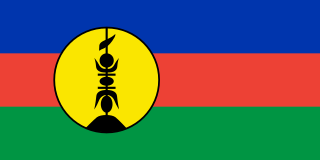
The geography of New Caledonia (Nouvelle-Calédonie), an overseas collectivity of France located in the subregion of Melanesia, makes the continental island group unique in the southwest Pacific. Among other things, the island chain has played a role in preserving unique biological lineages from the Mesozoic. It served as a waystation in the expansion of the predecessors of the Polynesians, the Lapita culture. Under the Free French it was a vital naval base for Allied Forces during the War in the Pacific.

Nouméa is the capital and largest city of the French special collectivity of New Caledonia. It is situated on a peninsula in the south of New Caledonia's main island, Grande Terre, and is home to the majority of the island's European, Polynesian, Indonesian, and Vietnamese populations, as well as many Melanesians, Ni-Vanuatu and Kanaks who work in one of the South Pacific's most industrialised cities. The city lies on a protected deepwater harbour that serves as the chief port for New Caledonia.
The Ouvéa cave hostage taking was an event that occurred from 22 April 1988 to 5 May 1988 in which members of an independence movement, the Kanak and Socialist National Liberation Front, assassinated four gendarmes and took 27 hostages, together with a public prosecutor and seven members of the French GIGN military unit, on the island of Ouvéa, New Caledonia. They demanded talks with the French government about independence for New Caledonia from France.
The Nouméa Accord of 1998 is a promise by the French Republic to grant political power to New Caledonia and its original population, the Kanaks, until the territory decided whether to remain a special collectivity of France or become an independent state in a referendum held in 2018. France would continue to control military and foreign policy, immigration, police and currency until that time, and afterwards if the population chose to remain French.
Ajië is an Oceanic language spoken in New Caledonia. It has approximately 4,000 speakers.

Caldoche is the name given to European inhabitants of the French overseas collectivity of New Caledonia, mostly native-born French settlers. The formal name to refer to this particular population is Calédoniens, short for the very formal Néo-Calédoniens, but this self-appellation technically includes all inhabitants of the New Caledonian archipelago, not just the Caldoche. Another "white" demographic element in the territory is expatriates from metropolitan France who live there temporarily as civil servants. Caldoches emphasise their position as permanent locals, referring to them as métros or as Zoreilles in local slang.
Drehu is an Austronesian language mostly spoken on Lifou Island, Loyalty Islands, New Caledonia. It has about twelve-thousand fluent speakers and the status of a French regional language. This status means that pupils can take it as an optional topic for the baccalauréat in New Caledonia itself or French mainland. It has been also taught at the Institut National des Langues et Civilisations Orientales (INALCO) in Paris since 1973 and at the University of New Caledonia since 2000. As for other Kanak languages, Drehu is now regulated by the "Académie des langues kanak", officially founded in 2007.

Houaïlou is a commune in the North Province of New Caledonia, an overseas territory of France in the Pacific Ocean.

César Chesneau, sieur Dumarsais or Du Marsais was a French philosophe, grammarian and contributor to the Encyclopédie ou Dictionnaire raisonné des sciences, des arts et des métiers.
Tayo, also known as "patois de Saint-Louis", is a French-based Creole spoken in New Caledonia. It is the community language of one village, Saint-Louis, which is situated approximately 17 kilometres from the capital Noumea.
The Centre de Recherche et de Documentation sur l'Océanie, also known as CREDO is a cross-disciplinary research laboratory in social and cultural anthropology, history and archaeology including researchers and lecturers from three institutions: the CNRS, the EHESS and the University of Provence. Its main focus of research and teaching are the past and contemporary societies of the Pacific, Australia included.
The Nemi language is a Kanak language spoken by 320 people in the north of New Caledonia, in the commune of Hienghène.
Jawe is one of the Kanak languages spoken in the northern province of the largest island of New Caledonia named Grande Terre. Jawe speakers are located along the northeast coast of the island, north of Hienghène and south of Pouébo; primarily in the Cascada de Tao region, Tchambouenne, and in the upper valleys of both sides of the centrally dividing mountain range.
Arthur René Jean Baptiste Bavay was a French pharmacist, herpetologist and malacologist.
Jean Armand Isidore Pancher was a French gardener and botanist.
Karima Dirèche is a French Algerian historian specialising in the contemporary history of the Maghreb. Since September 2013, she has been the director of the Institute for Research on the Contemporary Maghreb in Tunis.
Maurice Olender is a French historian, professor at the École des hautes études en sciences sociales (EHESS) in Paris. His teaching focuses in particular on the genesis of the idea of "race" in the nineteenth century. As editor, he heads the journal Le Genre humain and La librairie du XXIe siècle at Éditions du Seuil

An independence referendum was held in New Caledonia on 4 November 2018. Voters were given the choice of remaining part of France or becoming an independent country.
Déwé Gorodey, or Déwé Gorodé, is a New Caledonian teacher, writer, feminist and politician. She was active in agitating for independence from France in the 1970s. She has published poetry, short stories and novels. From 1999 she has been a member of the New Caledonia government, representing the pro-independence Kanak and Socialist National Liberation Front. From April 2001 to June 2009 she served almost continuously as Vice President of the Government of New Caledonia.











